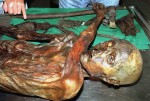Scientists finally determine iceman Otzi’s last meal
In a presentation at the Seventh World Congress on Mummy Studies, researchers from the Institute for Mummies and the Iceman revealed that they had finally located the iceman known as Otzi’s stomach and determined his last meal. They were also able to successfully sequence his entire genome.

Otzi the Iceman, a well-preserved natural mummy of a
Chalcolithic (Copper Age) man from about 3300 BC,
who was found in 1991 in the Schnalstal glacier
in the Ötztal Alps, near Hauslabjoch on the
border between Austria and Italy.
Researchers from the Institute for Mummies and the Iceman in Italy divided the presentation into three different topics. The first part of the presentation was given by microbiologist Frank Maixner. He had recently examined old tomography scans taken of Otzi back in 2005 and was able to finally locate the stomach which was farther up in the torso and in an unusual position. They found the stomach to be full and, upon examination and sequencing of the DNA, they determined that Otzi had eaten Alpine ibex just 30 to 120 minutes before his death.
The next presentation was led by anatomist Frank Ruhli and dentist Roger Seiler from the Centre for Evolutionary Medicine through the University of Zurich. They presented the dental health of Otzi who was presumed to have dies between the age of 35 and 40. Using three-dimensional images of his teeth, they showed how Otzi had suffered some form of blunt force trauma to two teeth only a few days before his death. They also showed how he suffered from periodontal disease and many cavities. These signs of cavities confirm the fact that the Iceman had consumed a diet full of carbohydrates.
The final part of the presentation was led by geneticist Angela Graefen from the Institute for Mummies and the Iceman. She reported that her team had finally succeeded in sequencing Otzi’s full genome. This genome has already shed some light on some previous beliefs. While most artists performing facial reconstructions of Otzi have shown him with blue eyes, the new sequenced genome show that he probably had brown eyes.[sc:BR]
Genetic analysis reveals Otzi Iceman predisposed to cardiovascular disease

New reconstruction of the Iceman as presented in the
South Tyrolean Archaeology Museum showing the Iceman
with brown eyes based on the genetic analysis.
Scientific magazine Nature Communications publishes new findings about physiognomy, ethnic origin and predisposition towards illness of the world’s oldest glacier mummy.
Roughly eighteen months ago, a team of scientists succeeded in decoding the full genome of Ötzi, the mummified Iceman, revealing his entire genetic make-up. Thus the course was set for solving further mysteries surrounding the world’s oldest glacier mummy. And now the next milestone has been reached: researchers from the Institute for Mummies and the Iceman at the European Academy of Bolzano/Bozen (EURAC), and from the Institutes for Human Genetics at the University of Tübingen and Saarland University have analysed various aspects of the raw data gained from the DNA sequencing. Their findings have now been published in the scientific magazine Nature Communications.
Ötzi was genetically predisposed to cardiovascular diseases, according to recent studies carried out by the team of scientists working with Albert Zink and Angela Graefen from Bolzano’s EURAC Institute for Mummies and the Iceman, Carsten Pusch and Nikolaus Blin from the Institute for Human Genetics at the University of Tübingen, along with Andreas Keller and Eckart Meese from the Institute of Human Genetics at Saarland University. Not only was this genetic predisposition demonstrable in the 5,000-year-old ice mummy, there was also already a symptom in the form of arteriosclerosis, or hardening of the arteries. And yet, in his lifetime, Ötzi was not exposed to the risk factors which we consider today to be the significant triggers of cardiovascular disease. He was not overweight and no stranger to exercise. “The evidence that such a genetic predisposition already existed in Ötzi’s lifetime is of huge interest to us. It indicates that cardiovascular disease is by no means an illness chiefly associated with modern lifestyles. We are now eager to use these data to help us explore further how these diseases developed” says anthropologist Albert Zink with bioinformatics expert Andreas Keller.
Apart from this genetic predisposition, the scientists were able to identify traces of bacteria from the genus Borrelia, which are responsible for causing infections and are transmitted by ticks. Carsten Pusch, who led the genetic investigations in Tübingen, comments: “This is the oldest evidence for borreliosis (Lyme disease) and proof that this infection was already present 5,000 years ago.”
One further aspect which particularly interested the scientists was the Iceman’s genetic. They found that Ötzi belonged to a particular so-called Y-chromosome haplogroup which is relatively rare in present-day Europe. The findings indicate that Ötzi’s ancestors had migrated from the Middle East as agriculture and cattle-breeding became more widespread. Their genetic heritage is most common today in geographically isolated areas and islands such as on Sardinia and Corsica.
The genetic investigations also revealed a wealth of further information facts about the physical appearance of the Iceman: he had brown eyes, brown hair, and suffered from lactose intolerance which meant he could not digest milk products. This finding supports the theory that, despite the increasing spread of agriculture and dairying, lactose intolerance was still common in Ötzi’s lifetime. The ability to digest milk throughout adulthood developed steadily over the next millennia alongside the domestication of animals.
The full genome sequencing was supported by the National Geographic Society (USA), by Life Technologies (USA) and Comprehensive Biomarker Center (Germany).[sc:BR]
No living relatives for Otzi
The Tyrolean Iceman known as Otzi died in the Alps 5,000 years ago, but despite his relative youth, scientists have discovered that he has no genetic descendants.
Earlier study of the DNA showed that he belonged to the lineage, or “subhaplogroup,” known as K1. About 8% of modern Europeans belong to the K haplogroup, meaning that they share a common ancestor, and that group is divided into two “subhaplogroups,” K1 and K2. The K1 haplogroup, in turn, can be divided into three clusters.
In the new study, the researchers took advantage of advanced genome-sequencing technologies to shed more light on the Iceman’s genetics. They sequenced his entire mitochondrial genome and compared that sequence to other published human mitochondrial DNA sequences to construct his evolutionary (or phylogenetic) family tree.
“The surprise came when we found that the lineage of the Iceman did not fit any of the three known K1 clusters,” Rollo said. His team has informally named the newly discovered branch on the human family tree “Otzi’s branch.”
This is unexpected news. He’s not all that old, really. You’d think there’d be some direct genetic link between him and modern Europeans, but nope.
It seems he was a member of a genetic group that is extinct now, or at least so rare that scientists have yet to find it.[sc:BR]
Otzi had Lyme disease
Researchers have analyzed Otzi the Iceman’s full nuclear genome sequence and discovered that he had Lyme disease. Otzi died 5300 years ago which makes his the earliest known human case of Lyme disease.
Otzi died 5300 years ago which makes his the earliest known human case of Lyme disease.
This study confirmed the results of an earlier study which sequenced his mitochondrial genome and found that he has no contemporary descendants. His ancestors in the K haplogroup migrated to Europe from the Middle East at some point during the Neolithic. Their descendants are few in number (only 8% of Europeans belong to the K haplogroup) and concentrated in isolated areas like Sardinia and Corsica. None of them are in Otzi’s branch of the K haplogroup.
 He also had brown hair, brown eyes (which matches the most recent reconstruction of his face; the first reconstruction gave him blue eyes), type O blood and lactose intolerance. Humans had been husbanding cattle for 5000 years by the time Otzi trekked the Alps, but it took us a few thousand more years of bovine domestication before the ability to digest milk became more common among adults. (Children produce lactase, the enzyme that metabolizes lactose, so they can nurse, but once they’re weaned lactase production decreases or stops altogether. That’s the default setting for all mammals. By domesticating cattle, some human populations, primarily in the northern hemisphere, gradually began to develop lactase persistence into adulthood.)
He also had brown hair, brown eyes (which matches the most recent reconstruction of his face; the first reconstruction gave him blue eyes), type O blood and lactose intolerance. Humans had been husbanding cattle for 5000 years by the time Otzi trekked the Alps, but it took us a few thousand more years of bovine domestication before the ability to digest milk became more common among adults. (Children produce lactase, the enzyme that metabolizes lactose, so they can nurse, but once they’re weaned lactase production decreases or stops altogether. That’s the default setting for all mammals. By domesticating cattle, some human populations, primarily in the northern hemisphere, gradually began to develop lactase persistence into adulthood.)
A more surprising discovery is that he was genetically predisposed to an increased risk of coronary heart disease.
Ötzi was genetically predisposed to cardiovascular diseases, according to recent studies carried out by the team of scientists working with Albert Zink and Angela Graefen from Bolzano’s EURAC Institute for Mummies and the Iceman, Carsten Pusch and Nikolaus Blin from the Institute for Human Genetics at the University of Tübingen, along with Andreas Keller and Eckart Meese from the Institute of Human Genetics at Saarland University. Not only was this genetic predisposition demonstrable in the 5,000-year-old ice mummy, there was also already a symptom in the form of arteriosclerosis, or hardening of the arteries. And yet, in his lifetime, Ötzi was not exposed to the risk factors which we consider today to be the significant triggers of cardiovascular disease. He was not overweight and no stranger to exercise. “The evidence that such a genetic predisposition already existed in Ötzi’s lifetime is of huge interest to us. It indicates that cardiovascular disease is by no means an illness chiefly associated with modern lifestyles. We are now eager to use these data to help us explore further how these diseases developed” says anthropologist Albert Zink with bioinformatics expert Andreas Keller. Via: thehistoryblog, phys













